Healthcare activities statistics - consultations
Data extracted in July 2023.
Planned article update: August 2024.
Highlights
On average, people in Slovakia, Germany and Hungary made 11.0, 9.6 and 9.5 visits, respectively, to consult medical doctors during the course of 2021 – the highest averages among the EU Member States.
People in the Netherlands made an average of 3.1 visits to dentists during the course of 2021, by far the highest ratio among the EU Member States.
People in Ireland (2018 data), Hungary, Romania (both 2021 data) and Cyprus (2020 data) made an average of less than 0.5 visits to dentists during the course of the year, the lowest ratios among the EU Member States.
Consultation of a medical doctor, 2021
This article presents an overview of European Union (EU) statistics related to consultations of medical professionals, in particular the consultation of doctors, dentists, psychologists, psychotherapists and physiotherapists.
This article is one of a set of statistical articles concerning healthcare activities in the EU which forms part of an online publication on health statistics.
While most of the statistics presented in this article are self-reported data relating to 2019, administrative data in Figures 1 and 4 are generally for 2021. As such, this article includes data that may have been impacted by the COVID-19 pandemic and its related restrictions. For this reason, particular attention should be paid when comparing the 2021 data with data from earlier years.
In some EU Member States, healthcare resources were placed under intense pressure (particularly at the start of the pandemic) from an influx of patients with COVID-19. The pandemic also resulted in a range of knock-on effects including, among others, some services being curtailed/postponed due to the number of COVID-19 patients, staff shortages within hospitals, day care centres and doctor’s/dentist’s surgeries due to infection/quarantine procedures, and patients being hindered accessing medical services due to their own infection/quarantine as well as lockdown, travel or other restrictions.
Full article
Consultations of doctors
Statistics on the average number of consultations that people have with a physician include consultations at the physician’s office, in the patient’s home, or in out-patient departments of hospitals or ambulatory health care centres. These figures exclude consultations/visits during a treatment as part of in-patient or day care patient care in a hospital or similar institution. In general, they also exclude remote consultations, such as by telephone.
Among the EU Member States, there is a wide range in the frequency with which medical doctors are consulted. In Sweden and Greece, people consulted physicians, on average, less than 3.0 times during 2021; older data for Cyprus also indicate a low frequency. The average number of consultations generally ranged between 3.5 and 7.8 in most EU Member States (no recent data for Malta). The highest frequencies for consultations of physicians during 2021 were recorded in the Netherlands (8.6 per person; including telephone consultations), Hungary (9.5), Germany (9.6; only including cases according to reimbursement regulations) and Slovakia (11.0; including telephone consultations).
Compared with the average for 2018 to 2020, the average number of consultations decreased in 2021 in 19 of the 24 EU Member States for which data are available (see Figure 1 for data availability). The exceptions were Czechia, Austria, Poland, Latvia and Slovakia; note that there was a change in coverage for Austria. The largest decreases in both relative and absolute terms were recorded for Italy (down 39 %; 3.3 fewer consultations per person) and Lithuania (down 24 %; 2.0 fewer consultations per person).
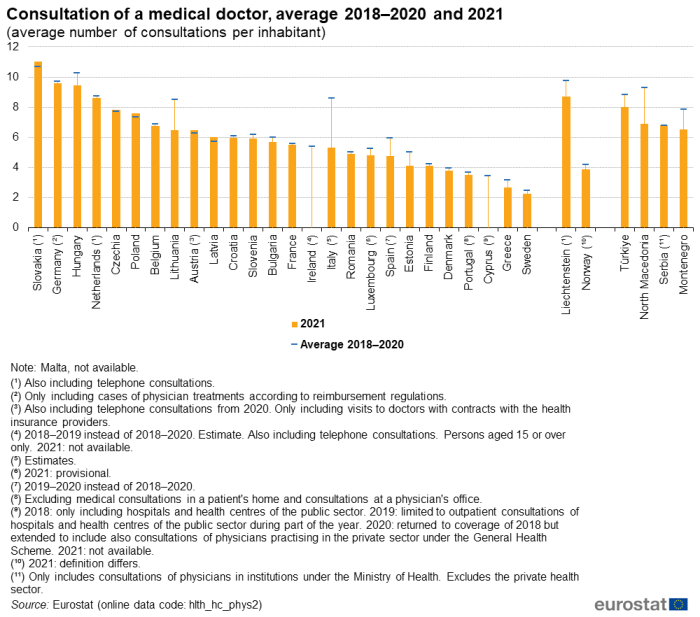
(average number of consultations per inhabitant)
Source: Eurostat (hlth_hc_phys2)
The proportion of the population who had consulted general practitioners was higher than the proportion who had consulted specialist medical practitioners
Figures 2 and 3 present self-reported data on consultations from the third wave of the European health interview survey (EHIS). This was conducted for the 2019 reference year. Both of these figures show the percentage of the population aged 15 years or over having consulted medical professionals during a four-week period prior to the date when the survey was conducted. The proportion of people aged 15 years or over having consulted a general practitioner (as shown in Figure 2) was higher than the proportion having consulted a specialist medical practitioner (as shown in Figure 3). This pattern was observed for males and for females in all EU Member States, as well as in Iceland, Norway and Serbia. A different pattern was observed in Türkiye, as males and females were more likely to have consulted a specialist medical practitioner.
Across the EU, just less than three tenths (28.6 %) of males aged 15 years or over and more than one third (36.3 %) of females of the same age consulted a general practitioner (during the four-week period leading up to the survey in 2019). The highest proportions of people (males and females) aged 15 years or over having consulted a general practitioner were recorded in Poland (63.7 %) and Croatia (46.6 %). An analysis by sex reveals that nearly three quarters (72.9 %) of all females aged 15 years or over in Poland consulted a general practitioner (during the four-week period leading up to the survey in 2019), while the highest share of males consulting a general practitioner was also recorded in Poland (53.8 %). As such, Poland was the only EU Member State where more than half of all males consulted a general practitioner.
Females were more likely than males to have consulted a general practitioner …
In all of the EU Member States, females were more likely than males to have consulted a general practitioner during the four weeks prior to the survey in 2019. For general practitioners, the difference between the sexes was more than 10.0 percentage points in Denmark, Bulgaria, Hungary, Lithuania, Latvia, Sweden and Poland (where the largest difference among the Member States was recorded, 19.1 percentage points); there was also a double-digit gap between the sexes in Türkiye. By contrast, the gender gap was less than 4.5 percentage points in Estonia, Czechia, Cyprus and Finland.
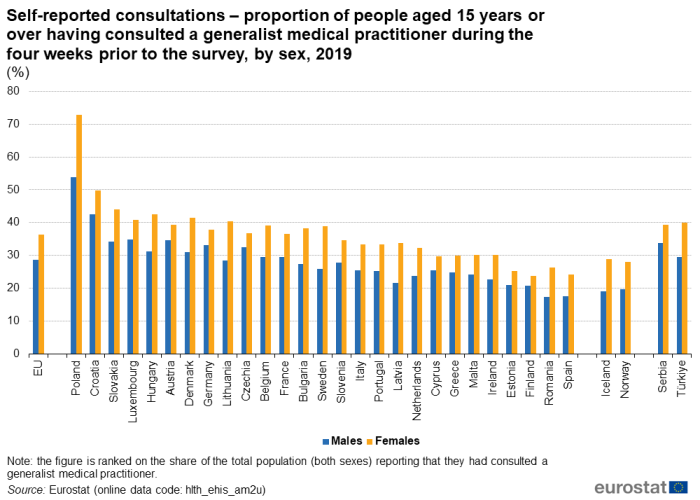
(%)
Source: Eurostat (hlth_ehis_am2u)
The situation for specialist medical practitioners was somewhat different as, across the EU, 16.5 % of males and 22.6 % of females aged 15 years or over consulted a specialist medical practitioner (during the four-week period leading up to the survey in 2019). Among the EU Member States, the highest proportion of people (males and females) having consulted a specialist medical practitioner was recorded in Poland (38.9 %), while more than one quarter of people aged 15 years or over in Luxembourg, Czechia, Austria, Slovakia and Hungary also consulted a specialist medical practitioner. Poland recorded the highest share of males (30.8 %) and females (46.9 %) having consulted a specialist medical practitioner.
… or a specialist practitioner
As for general practitioners, in all of the EU Member States females were more likely than males to have consulted a specialist medical practitioner during the four weeks prior to the survey in 2019. For consultations of specialist medical practitioners, the difference between the sexes ranged from 16.1 percentage points in Poland and at least 10.0 percentage points in Hungary, Luxembourg, Czechia and Slovakia to less than 3.0 percentage points difference in Bulgaria, Finland, Romania and Ireland (where the lowest difference was recorded, 1.7 percentage points). There was also a double-digit gap between the sexes in Türkiye.
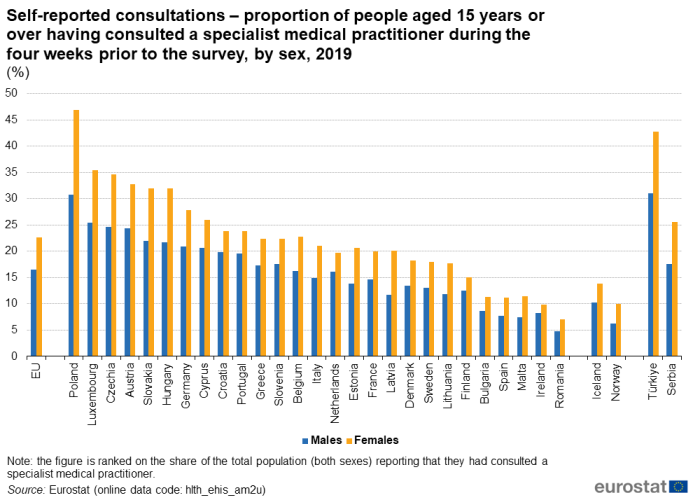
(%)
Source: Eurostat (hlth_ehis_am2u)
The data presented in Tables 1 and 2 also come from the third wave of the EHIS and these present an analysis by age group.
In all of the EU Member States, the proportion of people aged 15 years or over having consulted a general practitioner was lowest among persons aged 15–24 years or those aged 25–34 years. Among older age groups, the share of the population having consulted a general practitioner tended to rise steadily to peak among those aged 65–74 years or, more commonly, 75 years or over.
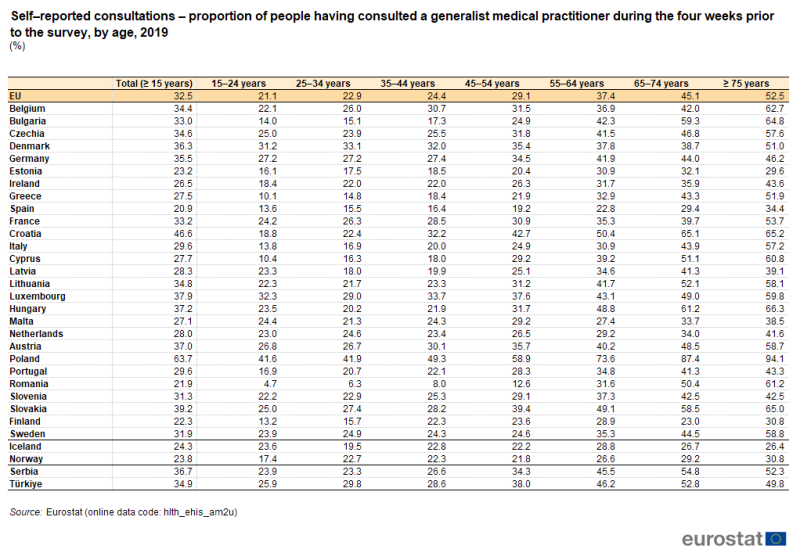
(%)
Source: Eurostat (hlth_ehis_am2u)
The same pattern was observed for the proportion of the population having consulted a specialist medical practitioner (see Table 2): the lowest proportions were recorded for one of the two youngest age groups and the highest proportions for either those aged 65–74 years or those aged 75 years or over.
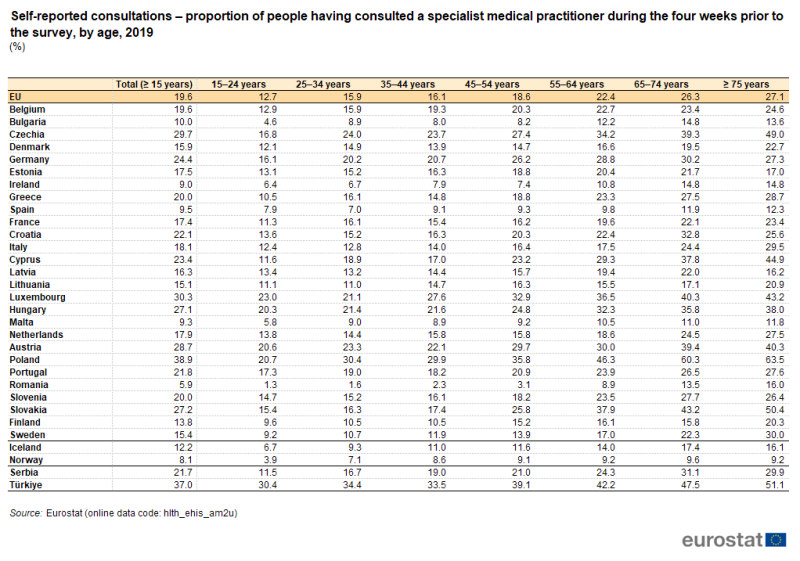
(%)
Source: Eurostat (hlth_ehis_am2u)
Consultations of dentists
In 2021, the highest average number of consultations of dentists was in the Netherlands
The average number of consultations of dentists was far lower than the average number of consultations of medical doctors, as can be seen by comparing the scales of Figures 1 and 4. In Cyprus, Romania, Hungary and Ireland people consulted dentists, on average, less than 0.5 times during 2021. Most other EU Member States reported averages between 0.6 and 1.7 consultations. The Netherlands was well above this range, with an average of 3.1 consultations per inhabitant.
![a bar chart showing the consultation of a dentist in 2021 in the EU, EU Member States, some of the EFTA countries and candidate countries.]](/eurostat/statistics-explained/images/thumb/e/ee/Consultation_of_a_dentist%2C_2021_%28average_number_of_consultations_per_inhabitant%29_Health2023.png/700px-Consultation_of_a_dentist%2C_2021_%28average_number_of_consultations_per_inhabitant%29_Health2023.png)
(average number of consultations per inhabitant)
Source: Eurostat (hlth_hc_dent)
Figures 5 and 6 and Table 3 also provide information concerning self-reported consultations of dentists or orthodontists. Note however, that these data are from the EHIS and relate to when people aged 15 years or over had made their most recent visit to a dentist or orthodontist.
In 2019, almost 4 out of every 10 people (38.2 %) in the EU reported that they had visited a dentist or an orthodontist within the six months prior to the survey. The range in this share was generally from 23.7 % in Latvia to 48.2 % in Czechia, with lower shares recorded in Bulgaria (18.3 %) and Romania (10.9 %), while Denmark (54.2 %), Luxembourg (55.3 %), the Netherlands (58.2 %) and Germany (58.6 %) had higher shares. In a minority of EU Member States, a larger share of people aged 15 years or over declared that they had most recently consulted a dentist or an orthodontist at least one year earlier than had done so within the previous year (within the previous six months or 6–12 months). In Romania, more than three quarters (73.2 %) of people aged 15 years or over declared that the last time that they had visited a dentist or an orthodontist was at least one year previously, while shares of more than 50.0 % were also recorded in Bulgaria, Hungary and Latvia. There were three Member States where more than 4.0 % of people aged 15 years or over had never visited a dentist or orthodontist: Malta, Bulgaria and Romania.
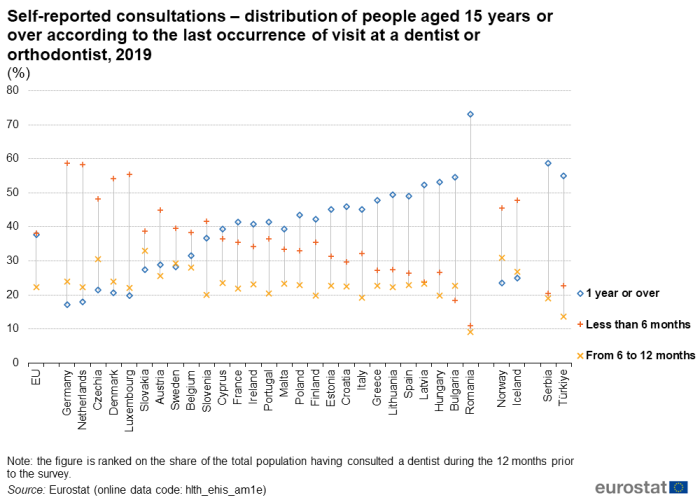
(%)
Source: Eurostat (hlth_ehis_am1e)
Females were more likely than males to have consulted a dentist
Similar to Figures 2 and 3 (which concerned consultations of general practitioners and specialist medical practitioners), Figure 6 shows that females aged 15 years or over were more likely to have consulted a dentist or an orthodontist within the previous year than males. However, the difference was less pronounced than for the consultation of medical doctors. On average in the EU, the proportion of persons having visited a dentist or an orthodontist within the year prior to the 2019 survey was 63.2 % for females and 57.7 % for males (a difference of 5.5 percentage points between the two sexes). This gender gap was consistently in favour of females across each of the EU Member States, with the broadest gaps (upwards of 8.0 percentage points difference) recorded in Latvia, Spain, Luxembourg and Ireland, peaking at 11.9 percentage points in Lithuania.
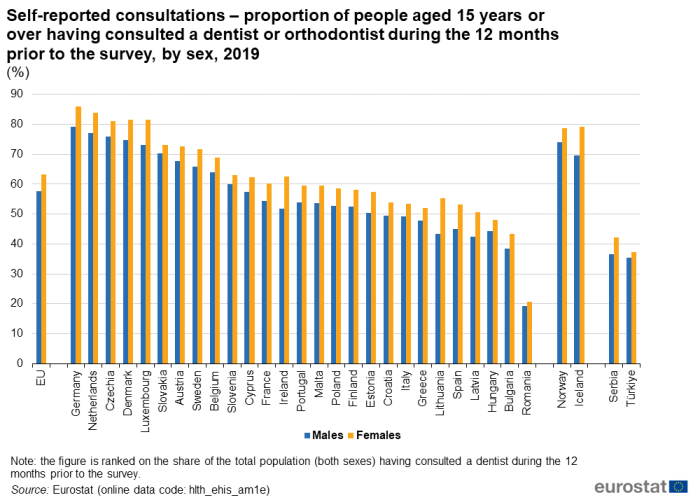
(%)
Source: Eurostat (hlth_ehis_am1e)
Older people were less likely to have consulted a dentist or an orthodontist within the previous year
An age group analysis for the proportion of people having consulted a dentist or an orthodontist during the 12 months prior to the EHIS revealed a quite different pattern from that observed for people consulting medical doctors. Whereas older people were among those most likely to visit a medical doctor (general practitioner or specialist medical practitioner), they tended to be less likely to visit a dentist than younger people.
In most of the EU Member States, the proportion of people aged 15 years or over having reported in 2019 that they had consulted a dentist or an orthodontist was relatively uniform across the different age groups through until the age of 55–64 years. A closer analysis of the data for older people reveals that a relatively low share consulted a dentist or an orthodontist during the 12 months prior to the latest survey. For example, in 22 of the EU Member States the proportion of the population aged 65–74 years reporting having visited a dentist or an orthodontist within the previous year was below the average for all people aged 15 years or over. Among people aged 75 years or over, the proportion was below the average for all people aged 15 years or over in all Member States except for the Nordic Member States of Finland, Denmark and Sweden.
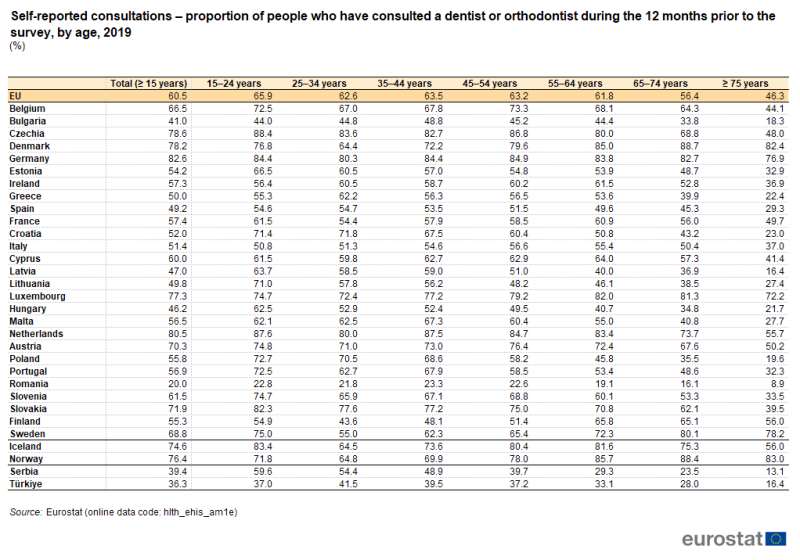
(%)
Source: Eurostat (hlth_ehis_am1e)
Consultations of psychologists, psychotherapists or psychiatrists
Psychologists study the mind and its functions, in particular in relation to individual and social behaviour. Psychiatrists, however, are medical doctors who specialise in the prevention, diagnosis and treatment of mental illness. They have post-graduate training in psychiatry and may also have additional training in a psychiatric specialty, such as neuropsychiatry or child psychiatry. The EHIS included questions asking respondents about their medical consultations with psychologists, psychotherapists or psychiatrists.
In 2019, some 6.5 % of the EU population had consulted a psychologist, psychotherapist or psychiatrist in the 12 months prior to the EHIS. In almost all of the EU Member States (see Figure 7), the proportion of people (aged 15 years or over) having consulted a psychologist, psychotherapist or psychiatrist was higher for females than for males. The only exception was Cyprus, where the share recorded for males was higher than that for females.
The share of females who consulted a psychologist, psychotherapist or psychiatrist was particularly high when compared with the corresponding share for males in the Nordic Member States and Luxembourg. This pattern was also repeated in Iceland and Norway.
Overall (both sexes combined), the proportion of the population aged 15 years or over who had consulted a psychologist, psychotherapist or psychiatrist within the 12 months prior to the EHIS was generally within the range of 3.5 % to 10.4 % across the vast majority of EU Member States. Lower shares were recorded in Bulgaria, Cyprus and Romania (where the lowest proportion, 0.9 %, was recorded), while shares above this range were recorded in Germany and Sweden (where the highest proportion, 11.2 %, was recorded).
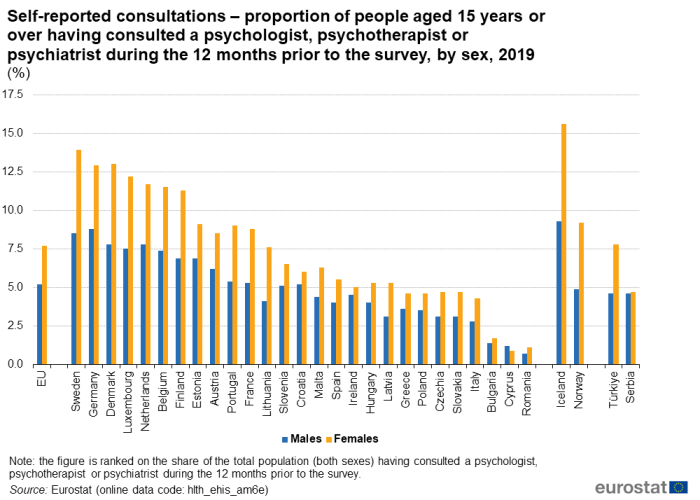
(%)
Source: Eurostat (hlth_ehis_am6e)
Young people or those in late middle age were most likely to have consulted a psychologist, psychotherapist or psychiatrist
An analysis by age (see Table 4) shows the proportion of people aged 15 years or over having consulted a psychologist, psychotherapist or psychiatrist within the 12 months prior to the EHIS often peaked among those aged 15–24 years or among those aged 55–64 years; this was the case in 15 EU Member States, while the age groups 25–34 years and 45–54 years were the next most likely to have the highest proportions. Lithuania was a clear exception, with the age group 75 years or over recording by far the highest proportion. The lowest shares of people aged 15 years or over consulting a psychologist, psychotherapist or psychiatrist were often recorded for the oldest age group (75 years or over) or the youngest (15–24 years).
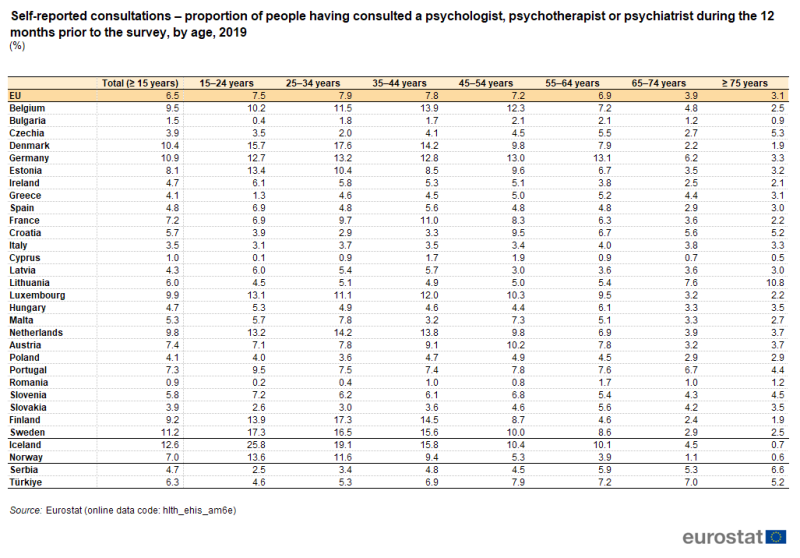
(%)
Source: Eurostat (hlth_ehis_am6e)
In the EU, people living in cities were more likely to consult a psychologist, psychotherapist or psychiatrist
In 2019, some 7.8 % of people living in EU cities consulted a psychologist, psychotherapist or psychiatrist during the 12 months prior to the EHIS (see Figure 8). The corresponding shares for people living in towns and suburbs (6.2 %) or rural areas (4.9 %) were lower. This pattern was not universal across the EU Member States.
- In 15 Member States, as well as in Iceland and Norway, the highest proportion was recorded for people living in cities, followed by towns and suburbs and then rural areas.
- A broadly similar situation was observed in Belgium and Luxembourg, although in each case two of the degree of urbanisation categories had the same proportions.
- In Ireland, Greece and Romania, the highest proportion was also recorded for people living in cities, but the lowest was for people living in towns and suburbs.
- In Bulgaria, Estonia, Latvia, Lithuania, Portugal and Slovakia, the highest proportion was recorded among people living in towns and suburbs.
- Cyprus was the clearest exception in that it had the reverse pattern to the one most commonly observed: the highest proportion of consultations with a psychologist, psychotherapist or psychiatrist in Cyprus was recorded among people living in rural areas and the lowest among those living in cities.
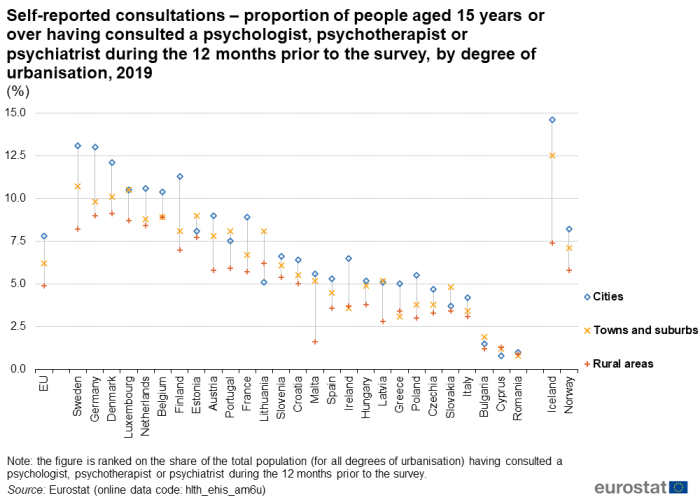
(%)
Source: Eurostat (hlth_ehis_am6u)
Consultations of physiotherapists
Physiotherapists assess, plan and implement rehabilitative programmes that improve or restore human motor functions, maximise movement ability, relieve pain syndromes, and treat or prevent physical challenges associated with injuries, diseases and other impairments. They apply a broad range of physical therapies and techniques such as movement, ultrasound, heating, laser and other techniques.
Across the EU Member States, the proportion of people aged 15 years or over having consulted a physiotherapist in the 12 months prior to the EHIS in 2019 generally ranged from 8.6 % to 32.6 %, with Ireland (5.4 %), Bulgaria (4.4 %) and Romania (4.0 %) below this range and Luxembourg (40.0 %) above it (see Figure 9).
On average, a higher proportion of females aged 15 years or over than males of the same age consulted physiotherapists, 22.1 % and 16.9 %, respectively, across the EU in 2019. This pattern was also apparent across most of the EU Member States with two exceptions: in Cyprus and Malta, males were more likely than females to have consulted a physiotherapist although the differences between the sexes were relatively small. By contrast, the largest gender gaps in favour of females were recorded in Belgium, Germany, the Netherlands and Luxembourg, where the proportion of females consulting a physiotherapist was between 8.8 and 11.6 percentage points higher than the proportion for males.
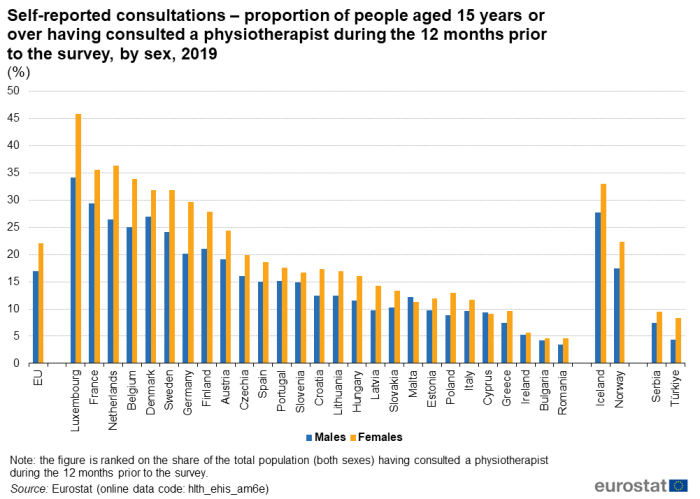
(%)
Source: Eurostat (hlth_ehis_am6e)
Recourse to physiotherapists higher among middle aged people
A further analysis for 2019 shows that the proportion of people aged 15 years or over having consulted a physiotherapist across the EU increased from 14.1 % among the youngest age group (people aged 15–24 years) – which was the lowest proportion among all age groups – up to 22.2 % for the age group 45–54 years. It then decreased slightly for people aged 55–64 years (21.9 %) and then decreased somewhat more strongly for people aged 65–74 years (20.1 %) and people aged 75 years or over (18.3 %).
In 2019, there were 12 EU Member States where the highest proportion of people consulting a physiotherapist was recorded for those aged 45–54 years (in one case joint highest with another age group). In most of the remaining Member States, the highest proportion was observed in one of the three older age groups. Denmark, France and Malta were the exceptions, recording their highest proportions among people aged 35–44, 25–34 and 15–24 years, respectively.
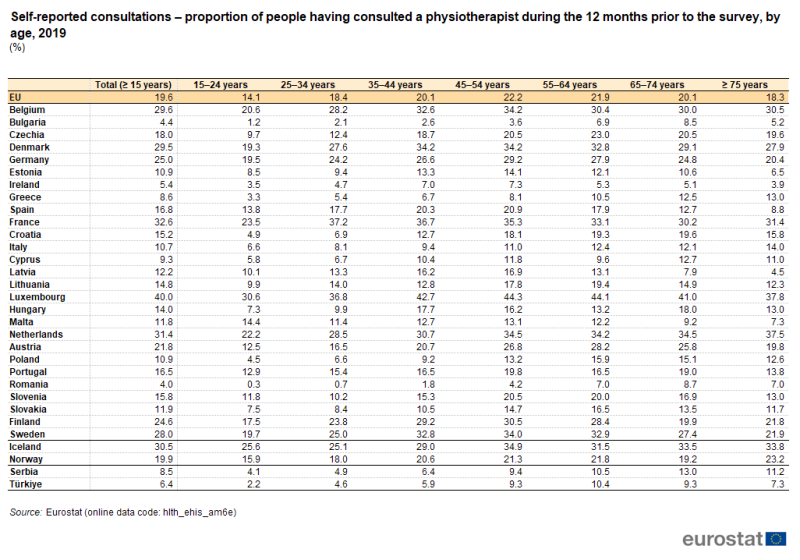
(%)
Source: Eurostat (hlth_ehis_am6e)
One-fifth of people in towns and suburbs and in cities in the EU consulted a physiotherapist
Figure 10 presents the proportion of people in the EU having consulted a physiotherapist in the 12 months prior to the EHIS. In 2019, this share was 20.0 % for the population living in cities as well as for those living in towns and suburbs. By contrast, it stood at 18.2 % for people living in rural areas.
When analysed according to the degree of urbanisation, there were considerable variations between EU Member States in the proportion of people aged 15 years or over having consulted a physiotherapist in the 12 months prior to the EHIS.
- In 16 Member States, this proportion was lowest among the population living in rural areas (compared with cities or with towns and suburbs); this was also the case in Iceland. Among those Member States that deviated from this pattern, most (seven) recorded their lowest proportion in cities, as did Norway. In the remaining four Member States – Bulgaria, Ireland, Cyprus and Sweden – their lowest share was recorded among people living in towns and suburbs.
- In 12 Member States, this proportion was highest among people living in cities; these included Lithuania where it was joint highest in cities and in towns and suburbs. In 11 others, it was highest in towns and suburbs (this was also the case in Iceland and Norway); these included France where the share was equally high in towns and suburbs and in rural areas. Rural areas recorded the highest proportions in Germany, Ireland, Luxembourg and Sweden.
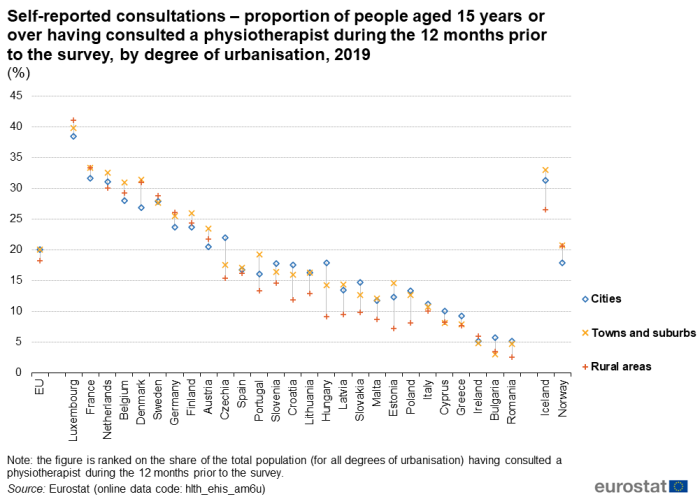
(%)
Source: Eurostat (hlth_ehis_am6u)
Source data for tables and graphs
Data sources
This article presents data on consultations of medical professionals from two types of sources. One of these mainly relies on administrative data whereas the other is based on self-reported consultations from population or household surveys.
Healthcare resources and activities
Statistics on healthcare resources and healthcare activities (such as information on consultations of doctors and dentists) are documented in this background article which provides information on the scope of the data, its legal basis, the methodology employed, as well as related concepts and definitions. Consultations of doctors generally exclude telephone contacts, visits for prescribed laboratory tests, or visits to perform prescribed and scheduled treatment procedures (such as injections and physiotherapy). Consultations of dentists include consultations of dental specialists, such as orthodontists.
For country specific notes on these data collections, please refer to the annexes at the end of the national metadata reports accessible from links at the beginning of the European metadata report.
The Healthcare non-expenditure statistics manual provides an overview of the classifications, both for mandatory variables and variables provided on voluntary basis.
Health status
Self-reported statistics on consultations of doctors, dentists, psychologists, psychotherapists, psychiatrists and physiotherapists are provided by the European health interview survey (EHIS). This source is documented in more detail in this background article which provides information on the scope of the data, its legal basis, the methodology employed, as well as related concepts and definitions.
Context
Medical consultations are usually held in a doctor’s surgery/dentist’s practice or another place for the provision of ambulatory care, including out-patient care in hospitals, although medical professionals may also travel to patients, for example, in the case of an accident or emergency, or a home visit. Consultations may also be remote, for example by telephone, but such consultations should not be included in the data presented here; when it is known that they have been included, such cases are footnoted in this article.
The frequency of consulting a particular type of medical professional may be influenced by the way doctors and other professionals are paid (either a fixed rate or as a function of the number and type of consultations and services provided), the range of services offered by other professionals (for example, some services may be provided by both nurses and doctors), and the division of work between generalist and specialist practitioners.
From the patient’s perspective, the time and monetary cost of a consultation may be factors which influence their decision to seek a consultation, alongside their perception as to their own needs for professional assistance. The frequency of consultations is also related to socio-demographic factors, such as age and sex.
Direct access to
Online publications
Healthcare resources
Healthcare activities
- Hospital discharges and length of stay
- Medicine use
- Cancer screening statistics
- Surgical operations and procedures
- Unmet needs for medical care
Methodology
General health statistics articles
- Health (hlth), see:
- Health care (hlth_care)
- Consultations (hlth_consult)
- Self-reported time elapsed since last visit to a medical professional by sex, age and educational attainment level (hlth_ehis_am1e)
- Self-reported consultations of a medical professional by sex, age and degree of urbanisation (hlth_ehis_am2u)
- Self-reported consultations of a medical professional by sex, age and educational attainment level (hlth_ehis_am2e)
- Self-reported consultation of mental healthcare or rehabilitative care professionals by sex, age and educational attainment level (hlth_ehis_am6e)
- Consultation of a medical doctor per inhabitant (hlth_hc_phys2)
- Consultation of a dentist per inhabitant (hlth_hc_dent)
- Consultations (hlth_consult)
- Health care (hlth_care)
- Healthcare non-expenditure statistics (ESMS metadata file – hlth_res_esms)
- European health interview survey (ESMS metadata file – hlth_det_esms)
- European Health Interview Survey (EHIS wave 3) – Methodological manual – re-edition 2020